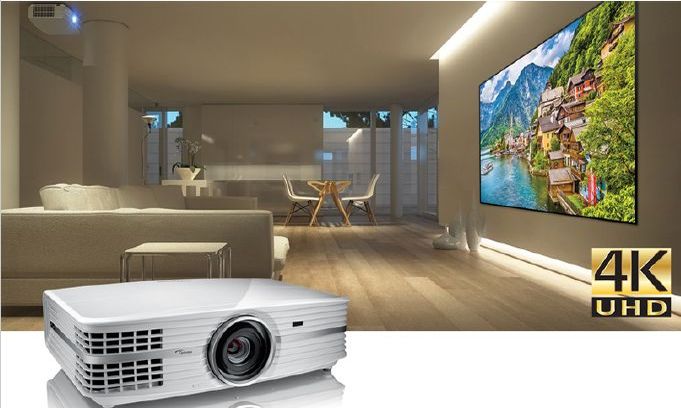Optoma UHD60 is considered one of the best 4K HDR projectors in the segment up to $ 2,000.00.
Today, it costs only $ 1,799.00, but some online stores offer this model even for $ 1,599.00. At the same time, Optoma UHD60 provides the highest brightness (3000 lm), the highest dinamic contrast ratio (1,000,000: 1) and the lowest noise level (only 28 dB) in its class.
As known, the Optoma UHD60 uses the 0.66″ DLP chipset. But most of its competitors today use the new 0.47″ DLP chipset, including the ViewSonic PX727-4K ($ 1,299), the Optoma UHD50 ($ 1,499), and the BenQ HT2550 ($ 1,499). New chipset is cheaper and consumes less.
On the other hand, the cost of the Optoma UHD60 with 0.66″ DLP chipset also dropped.
But the larger chip provides higher contrast, working with lumen output and contrast.
Brightness
Optoma UHD60 provides 3000 lm in Bright mode. Unfortunately, image in this mode has a clear green tint. The remaining preset modes are less bright, but provide much better color accuracy.
Of course, the UHD60 uses a BrilliantColor technology in the range from 1 to 10. As known, this technology uses six-segment color wheel to increase the brightness and saturation of the image by increasing the level of tints.
As known, it affects the saturation and contrast. Except Reference mode, its default value is 10 in all modes. In this case, the color brightness reaches only 55% of white, which provides lower color saturation and brightness compared to white.
Decreasing the BrilliantColor setting reduces the white level while maintaining the brightness level of the color. For example, a decrease from 10 to 6 reduces the luminous flux by about 17%, but the color does not change. In this case, the brightness of the color will be about 70% of white, increasing the saturation of the color and its contrast.
Thus, the maximum BrilliantColor is optimal for a room with some ambient light, a large screen or a low-gain screen. However, in a dark room you may want to experiment with BrilliantColor in the range from 5 to 7.
ANSI lm for modes with BrilliantColor of 10:
– Cinema – 1260;
– Vivid – 1591;
– HDR – 1021;
– Bright – 2710;
– Game – 1525;
– Reference -515.
Eco mode reduces light output by 37%, but is only available without Dynamic Black.
Features
The model uses a 1.6x zoom lens that loses 26% of the maximum light flux. Of course, this is too much for such a zoom lens. But, reducing the distance to the screen solves this problem.
The UHD60 has an input lag of 63 ms with Dynamic Black on and 56 ms with Dynamic Black off.
The UHD60 uses an RGBCY wheel, which sometimes generates traditional for DLP technology rainbow effect (colored artifacts around the object contour).
However, the optimal settings for brightness, contrast and white level effectively reduce this effect.
Dynamic Black mode increases dynamic contrast ratio to 1,000,000: 1.
Wobulation technology increases the real resolution of the DMD matrix (2716 x 1528) to 3840 x 3160.
The UHD60 uses two 4-watt speakers, which provide a fairly loud sound and a good bass range. But, of course, serious home theater will require the full surround system.
Service life lamp reaches 4000 hours in full power mode, 10,000 hours in eco, and 15,000 hours in Dynamic Black mode. But a new lamp for the UHD60 today costs only $ 199.
A 1.6x zoom lens provides a projection distance of 12 to 19 feet for a 120-inch screen. Moreover, the internet offers various Projection Calculators for a quick and easy solution to this problem. Additionally, the low noise level does not limit the choice of its location. But using the wider angle end of the zoom will maximize light output.
The UHD60 has a built in throw angle, but unfortunately small lens shift.
PROS & CONS
PROS
– matrix with Ultra HD 4K resolution;
– wide color gamut;
– Throw Ratio 1.39 – 2.22:1;
– long lamp service life;
– powerful enough built-in speaker;
– high-quality lens with 1.6x zoom lens and lens shift;
– excellent color calibration (flesh tones look warm and natural without the cool bluish tint);
-very low fan noise;
– saturated image with accurate color rendering.
CONS
– very long input lag;
– the Ultra Resolution feature increases detail and sharpness. Unfortunately, the function also significantly increases the noise level, especially in HDR;
– unstable image luminance in eco mode causes flicker. But lowering BrilliantColor will allow you to reduce the brightness, for example, in Dynamic Black (15,000 hours of service lamp life) and not to use eco-mode at all;
– like other inexpensive 4K projectors, the UHD60 does not support 3D.
– unfortunately, the model does not have a keystone adjustment. Therefore, the centerline of the lens should be perpendicular to the screen plane.
Of course, all these factors affect the choice of the optimal projector.
This video shows some features of Optoma UHD60 4K projector.
